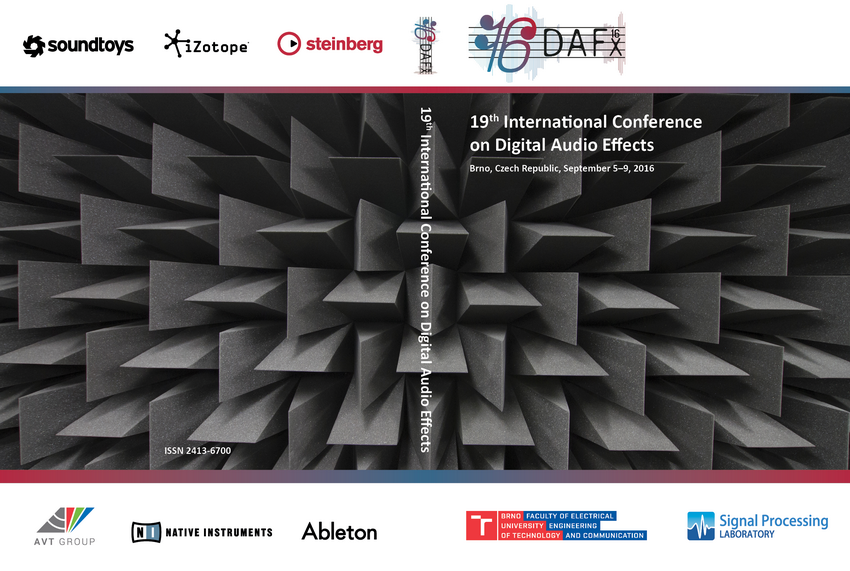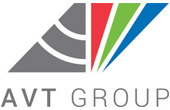| Papers |
| Oral Session 1: Time-Frequency Representation of Audio Signals |
Real-Time Audio Visualization With Reassigned Non-uniform Filter Banks
Zdeněk Průša and Nicki Holighaus |
Estimates of the Reconstruction Error in Partially Redressed Warped Frames Expansions
Thomas Mejstrik and Gianpaolo Evangelista |
Real-Time Spectrogram Inversion Using Phase Gradient Heap Integration
Zdeněk Průša and Peter L. Søndergaard |
Modifying Signals in Transform Domain: a Frame-Based Inverse Problem
Roswitha Bammer and Monika Dörfler |
| Oral Session 2: Virtual Analog |
Time-Variant Gray-Box Modeling of a Phaser Pedal
Roope Kiiski, Fabián Esqueda and Vesa Välimäki |
Black-box Modeling of Distortion Circuits with Block-Oriented Models
Felix Eichas and Udo Zölzer |
Physical Model Parameter Optimisation for Calibrated Emulation of the Dallas Rangemaster Treble Booster Guitar Pedal
Ben Holmes and Maarten van Walstijn |
Circuit Simulation with Inductors and Transformers Based on the Jiles-Atherton Model of Magnetization
Martin Holters and Udo Zölzer |
| Poster Session 1 |
A Cosine-Distance Based Neural Network for Music Artist Recognition Using Raw I-Vector Feature
Hamid Eghbal-Zadeh, Matthias Dorfer and Gerhard Widmer |
Hubness-Aware Outlier Detection for Music Genre Recognition
Arthur Flexer |
Separating Piano Recordings into Note Events Using a Parametric Imitation Approach
Xue Wen |
Assessing The Suitability of the Magnitude Slope Deviation Detection Criterion For Use In Automatic Acoustic Feedback Control
Marc C. Green, John Szymanski and Matt Speed |
A Robust Stochastic Approximation Method for Crosstalk Cancellation
Huaxing Xu, Risheng Xia, Junfeng Li and Yonghong Yan |
Simulation of Analog Flanger Effect Using BBD Circuit
Jaromír Mačák |
Audio Nonlinear Modeling through Hyperbolic Tangent Functionals
Adalberto Schuck Jr. and Bardo Ernst Josef Bodmann |
| Oral Session 3: Signal Processing |
Signal-Matched Power-Complementary Cross-Fading and Dry-Wet Mixing
Marco Fink, Martin Holters and Udo Zölzer |
Rounding Corners with BLAMP
Fabián Esqueda, Vesa Välimäki and Stefan Bilbao |
Time-Domain Implementation of a Stereo to Surround Sound Upmix Algorithm
Sebastian Kraft and Udo Zölzer |
| Oral Session 4: Sound Synthesis 1 |
Synthesis of Sound Textures with Tonal Components Using Summary Statistics and All-Pole Residual Modeling
Hyung-Suk Kim and Julius O. Smith |
Reducing the Aliasing of Nonlinear Waveshaping Using Continuous-Time Convolution
Julian D. Parker, Vadim Zavalishin and Efflam Le Bivic |
Sound Morphing by Audio Descriptors and Parameter Interpolation
Savvas Kazazis, Philippe Depalle and Stephen McAdams |
Real-Time Force-Based Sound Synthesis Using GPU Parallel Computing
Ryoho Kobayashi |
| Oral Session 5: Sound Synthesis 2 |
A Physical String Model with Adjustable Boundary Conditions
Maximilian Schäfer, Petr Frenštátský and Rudolf Rabenstein |
A Modal Approach to the Numerical Simulation of a String Vibrating Against an Obstacle: Applications to Sound Synthesis
Clara Issanchou, Jean-Loic Le Carrou, Stefan Bilbao, Cyril Touzé and Olivier Doaré |
A Real-Time Synthesis Oriented Tanpura Model
Maarten van Walstijn, Jamie Bridges and Sandor Mehes |
Assessing Applause Density Perception Using Synthesized Layered Applause Signals
Alexander Adami, Sascha Disch, Garri Steba and Jürgen Herre |
| Poster Session 2 |
Time Domain Aspects of Artifact Reduction in Positioning Algorithm using Differential Head-Related Transfer Function
Dominik Storek |
Detection of Clicks in Analog Records Using Peripheral-Ear Model
František Rund, Václav Vencovský and Jaroslav Bouše |
Perceptual Audio Source Culling for Virtual Environments
Ali Can Metan and Hüseyin Hacihabiboğlu |
Automatic Violin Synthesis Using Expressive Musical Term Features
Chih-Hong Yang, Pei-Ching Li, Alvin W. Y. Su, Li Su and Yi-Hsuan Yang |
Concatenative Sound Texture Synthesis Methods and Evaluation
Diemo Schwarz, Axel Roebel, Chunghsin Yeh and Amaury La Burthe |
Signal Decorrelation using Perceptually Informed Allpass Filters
Elliot Kermit-Canfield and Jonathan Abel |
Complexity Scaling of Audio Algorithms: Parametrizing the MPEG Advanced Audio Coding Rate-Distortion Loop
Pablo Delgado and Markus Lohwasser |
| Oral Session 6: Audio and Music Analysis |
Non-Linear Identification of an Electric Guitar Pickup
Antonin Novak, Leo Guadagnin, Bertrand Lihoreau, Pierrick Lotton, Emmanuel Brasseur and Laurent Simon |
Monophonic Pitch Detection by Evaluation of Individually Parameterized Phase Locked Loops
Johannes Böhler and Udo Zölzer |
Piecewise Derivative Estimation of Time-Varying Sinusoids as Spline Exponential Functions
Xue Wen |
| Oral Session 7: Wave Digital Filters |
The Fender Bassman 5F6-A Family of Preamplifier Circuits—A Wave Digital Filter Case Study
W. Ross Dunkel, Maximilian Rest, Kurt James Werner, Michael Jørgen Olsen and Julius O. Smith |
A Computational Model of the Hammond Organ Vibrato/Chorus using Wave Digital Filters
Kurt James Werner, W. Ross Dunkel and François Germain |
Resolving Grouped Nonlinearities in Wave Digital Filters using Iterative Techniques (updated version)
Michael Jørgen Olsen, Kurt James Werner and Julius O. Smith |
RT-WDF — A Modular Wave Digital Filter Library with Support for Arbitrary Topologies and Multiple Nonlinearities
Maximilian Rest, W. Ross Dunkel, Kurt James Werner and Julius O. Smith |
| Oral Session 8: Spatial Audio |
Directivity Patterns Controlling the Auditory Source Distance
Florian Wendt, Matthias Frank, Franz Zotter and Robert Höldrich |
Auditory Perception of Spatial Extent in the Horizontal and Vertical Plane
Marian Weger, Georgios Marentakis and Robert Höldrich |
Model-Based Obstacle Sonification for the Navigation of Visually Impaired Persons
Simone Spagnol, Omar I. Johannesson,
Arni Kristjansson, Runar Unnthorsson, Charalampos Saitis, Kyriaki
Kalimeri, Michal Bujacz and Alin Moldoveanu |
| |
| Keynotes |
Keynote 1: Peter Balazs - Frames in Audio Processing: What You Use, but Might Not Know
Given a certain number of
sampling points, can it be useful to represent them with a larger
collection of points/values? If not, why are spectrograms usually using
overlapping windows? Given a particular analysis filter bank, when and
how can a synthesis procedure be found that enables perfect
reconstruction? What are the conditions for that? Is a quadrature-mirror
condition the only way? How can a time-varying filter be implemented
by directly manipulating the time-frequency coefficients? What
properties do such time-frequency filters have? All those (and similar)
questions will be answered by using the theory of frames and its
application to audio signal processing.
Note: use DAFx16 Wireless Guest Access password to open the presentation. |
Keynote 2: Michael Hlatky - Design at Native Instruments
Since Native Instruments
introduced Generator, the first modular synthesizer for a desktop
computer environment more 20 years ago, the company has released a
large variety of hardware and software to perform and produce music.
This talk will give an insight into how we - the people working at NI -
design the hardware, develop the software, decide upon features and
what lessons we learned. |
Keynote 3: Sakari Tervo - Parametric Spatial Room Impulse Response Analysis and Synthesis: A High-Resolution Approach
The analysis of room
acoustics is of great interest in subjective and objective studies of
acoustic spaces. Often, the goal in room acoustic studies is to explain
the subjective experience of sound, for example, speech clarity or
bassiness, with the objective measurements of the sound field. In order
to describe a sound field spatially, a microphone array impulse response
measurement is required. This keynote lecture presents an approach to
the analysis and synthesis of the sound field measured with a microphone
array via parametric models. Estimation methods of the parameters in
the model, and the detection of which model fits the data the best are
described. Pros and cons of the parametric approach are discussed and
examples with some commercially available microphone arrays are
described. |
| |
| Tutorials |
Tutorial 1: Václav Peloušek & Lennart Schierling - Instrument Design Upside Down with Bastl Instruments
Emulating inherently digital
artefacts with analog technology? Sounds created by running sound
processing on processors virtually unable to render them? This Bastl
[local term for hack] mindset as a design approach for musical
instruments and tools has been the key for Bastl Instruments main
developer Václav Peloušek to creating a range of desktop hardware
instruments and eurorack modules. Analog and digital circuits running at
the edge of collapse to work in harmony as part of
digital-analog-mechanical hybrid systems. Lennart Schierling is the main
developer of Thyme - robot operated digital tape machine - very
universal sequencable hardware DSP processing unit to be released soon
by Bastl. |
Tutorial 2: Jaromír Mačák - Analog Effects Modeling - New Ways to Get Old Sounds
The term virtual analog
effects has been known in digital audio effects community for several
years. But until recently, this type of audio effects have been accepted
by a wider range of musicians and end users as adequate equivalent to
classic analog audio effects. This is due to a significant improvement
of the methods and algorithms for real-time digital simulation of analog
circuits. This tutorial will give an overview of basic techniques used
in virtual analog modeling based either on deep analysis of the circuit
schematic or measurement of analog audio effect. Pros and cons of both
approaches will be mentioned as well as real examples using these
techniques with attention for real-time implementation of these
algorithms. |
Tutorial 3: Jukka Pätynen & Sakari Tervo - Detailed Analysis of Room Acoustics by Spatiotemporal Methods
The analysis of sound fields
in rooms has been under interest for a long
time. Many traditional methods aim to describe the room-acoustic
effect in terms of single number values. However, numeric parameters
often fail in communicating the multi-dimensional effects. The
introduction of compact microphone arrays have enabled an increasingly
detailed analysis of the sound field. This tutorial will present the
latest advances in investigating the spatial, spectral, and temporal
structure of the acoustics of enclosures with visual techniques. These
methods are demonstrated with a recently published, freely available
analysis toolbox. |
| |







